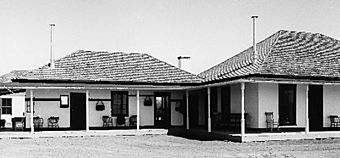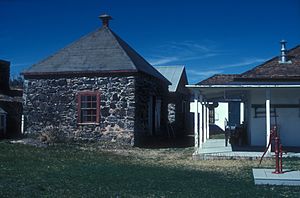San Bernardino Ranch facts for kids
|
San Bernardino Ranch
|
|

Main ranch house, 1985
|
|
| Location | Cochise County, Arizona, United States |
|---|---|
| Nearest city | Douglas, Arizona |
| Area | 205 acres (83 ha) |
| Built | 1822 |
| NRHP reference No. | 66000170 |
Quick facts for kids Significant dates |
|
| Added to NRHP | October 15, 1966 |
| Designated NHLD | July 19, 1964 |
The San Bernardino Ranch is a special historic ranch located in a beautiful valley in southeast Arizona, United States. It's close to the San Bernardino National Wildlife Refuge. This ranch is important because it shows where cattle ranching first started in southern Arizona and northern Mexico. The land here is also where the Yaqui River begins.
Many people know this place as the Slaughter Ranch. This is because it was the home of a famous Old West lawman named John Horton Slaughter. He lived here from the 1880s until he passed away in 1922. During a time of conflict near the border (called the Border War), the United States Army even set up a camp at the ranch in 1911.
The ranch was named a National Historic Landmark in 1964 because of its connection to John Slaughter. Today, you can visit the ranch house, wash house, icehouse, granary, and commissary. Many of these buildings are now part of a museum called the Johnson Historical Museum of the Southwest.
Contents
History of the Ranch
The San Bernardino Valley was originally home to Southern Athabaskan Native American tribes. The first Europeans to visit were Spanish missionaries, including Father Eusebio Kino, in 1694. Later, a Spanish fort was built here from 1775 to 1780.
In 1822, a large piece of land, about 73,240 acres (29,640 ha), was bought by Ignacio Perez. However, he had to leave his land in the 1830s because of conflicts with local Apache people. In 1846, the Mormon Battalion traveled through the property on their way to California. You can still see a historical marker about their journey today. Many other travelers also passed through the valley in the 1840s and 1850s. On June 8, 1854, the valley officially became part of the United States after the Gadsden Purchase from Mexico.
The Slaughter Ranch Era
In 1884, John Horton Slaughter, a cowboy and lawman from Texas, bought about 65,000 acres (26,000 ha) from Perez's family. A big part of his property was in Mexico, and the rest was in the Arizona Territory. There are even ruins on the property where one of Slaughter's employees built a house right on the U.S.–Mexico border. This house had two rooms, one in each country, connected by a walkway!
Slaughter became the sheriff of Cochise County, Arizona in 1886 and served for two terms until 1890. He was famous for bringing order to towns like Tombstone, Arizona after the well-known 1881 Gunfight at the OK Corral. People even called the Tombstone jail the "Hotel de Slaughter." He was known for being tough on outlaws.
John Slaughter, his second wife Viola Slaughter, her parents, and John's children from his first marriage lived at the ranch for many years. In 1887, a big earthquake in Sonora, Mexico, destroyed the Howell family's home on the property. The Howells helped manage the ranch until Slaughter finished his time as sheriff.
Slaughter had many people living and working on the ranch, sometimes as many as 500! This included many foster children. One special child was an Apache toddler named Apache May Slaughter. John Slaughter adopted her after her parents left her behind while he was tracking a group of people who had caused trouble in Arizona. John and Apache May loved each other very much. She called him "Don Juan." Sadly, she passed away at age 6 from burns when her dress caught fire. She is buried in the cemetery on what is now the wildlife refuge.
Children were a big part of life at the ranch. The Slaughters even built a schoolhouse for them, called Slaughter School District No. 28. The children loved to play in the natural springs and have picnics. Viola would bring them ice cream from the icehouse. They also enjoyed swimming in the house pond, which Slaughter had built for irrigation.
John Slaughter was very interested in new technology. His ranch was the first private home in southeast Arizona to have a telephone! He owned six cars, even though he never learned to drive them himself.
From 1911 to 1920, a military outpost for Camp Harry J. Jones was set up on the ranch. John Slaughter passed away peacefully in his sleep on February 16, 1922. Viola sold the property around 1936 to a friend, Marion Williams.
In 1968, Paul and Helen Ramsower bought the ranch. The San Bernardino Ranch was officially added to the National Register of Historic Places as a National Historic Landmark on August 7, 1964. The Ramsowers gave the ranch to The Nature Conservancy in 1980. In 1983, the Johnson Historical Museum of the Southwest bought the buildings. The United States Fish and Wildlife Service bought most of the remaining land. Today, 131 acres (53 ha) belong to the museum, and the rest is part of the San Bernardino National Wildlife Refuge. This refuge is home to special fish like the Yaqui Topminnow and Yaqui Chub, which are endangered and only found in this valley.
Ranch Buildings Today
The buildings at the San Bernardino Ranch have been carefully fixed up to look like they did in the early 1900s. This was done using old photos and stories from people who lived there. The buildings you can see include:
- Ranch house: This is an adobe building with a sloped roof and redwood shingles. It has six bedrooms, a living room, dining room, bathroom, kitchen, pantry, a special dining room for cowboys, and a porch.
- Ice house: This building is made of natural stone and was used to store ice.
- Wash house: Where laundry was done.
- Cook's room and commissary: A place for cooking and storing supplies.
- Granary: Used for storing grain.
- Car Shed: This shed holds a fully restored 1915 Model T Ford car.
Visiting the Museum
The Johnson Historical Museum of the Southwest is open to everyone! It's a popular spot for people who love to watch birds, school children, and anyone interested in the history of the Southwest. Mr. Floyd Johnson started the museum because he wanted "the youth of tomorrow may know what it was like yesterday."
The San Bernardino Ranch is located at 6153 Geronimo Trail, Douglas, Arizona 85608.
- Hours: Tuesday through Saturday, 9:30 AM – 3:30 PM
- Admission: $5.00 for adults; kids under 14 get in free.
- Closed: All major holidays.
- Pets: No pets are allowed.
See also




